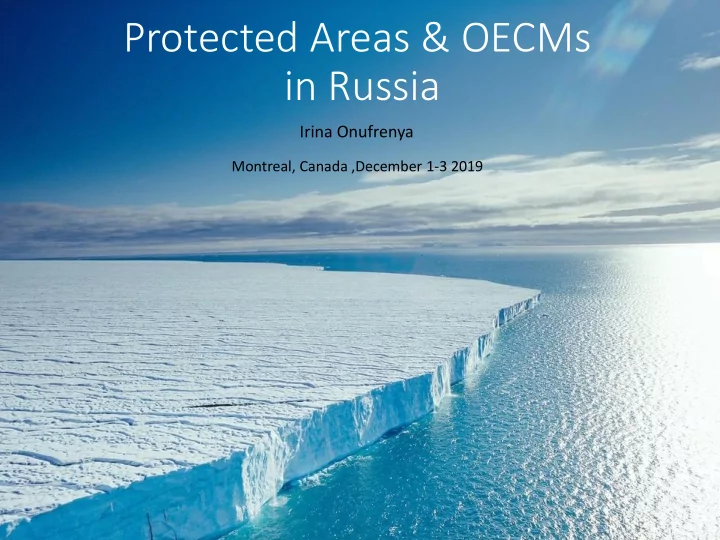

Protected Areas & OECMs in Russia Irina Onufrenya Montreal, Canada ,December 1-3 2019
GAP analysis and effectiveness of Protected Areas in Russia Terrestrial analysis was done in 2009 Marine analysis for the Arctic seas . was done in 2016 100 90 80 70 60 50 40 30 20 Assessments of the effectiveness 10 0 of Protected Areas at National and Regional levels are repeated. - potential effectiveness increasing - potential effectiveness increasing - current effectiveness by management improvement by removal of all factors
Protected Areas 11.7% of Russia , more than 13,000 PAs, total area 240 million ha (area of Germany, Switzerland, Italy, Belgium, Netherlands, Sweden, Norway, United Kingdom together) Federal (National) Regional & Municipal All Protected Areas are managed by the state at the National, Regional or Local levels.
Terrestrial PAs & OECMs in Russia
Protected Areas & OECMs PA doesn’t fits IUCN Criteria 0.2 PA fits IUCN Criteria 11.5 The remaining are of Russia 29.9 13.5 14.2 14.7 16 Different types of OECM (58,4%)
Terrestrial PAs & OECMs into administrative regions IUCN Categories PA only Ia Ib II III IV V VI PA & OECM Ia Ib II III IV V VI
Representativeness of Biomes geographical variations 60 50 40 Unprotected 30 Insufficiently Protected Sufficiently Protected (Low level) 20 Sufficiently Protected (Medium level) 10 Sufficiently Protected (High level) 0
Representativeness of Geographical Provinces 60 50 Unprotected 40 Insufficiently Protected 30 Sufficiently Protected (Low level) 20 Sufficiently Protected (Medium level) 10 Sufficiently Protected (High level) 0
Representativeness for conservation of Russian Red Data Book vertebrate animals Taxons Required PA as Protected on PA Unprotected Or conservation measures Insufficiently Protected Freshwater Fish 7 86% 1 (14%) Amphibia 6 67% 4 (67%) Reptilia 10 50% 7 (70%) Birds 121 100% 40 (33%) Mammals 49 98% 10 (20%) Total 193 94% 62 (32%) 140 120 100 80 60 40 Sufficiently Protected 20 Insufficiently Protected Unprotected 0 Fish Amphibia Reptilia Birds Mammals
Representativeness of the intact forests 350 300 250 200 150 Unprotected 100 Insufficiently Protected 50 Sufficiently Protected 0
Representativeness of the steppe 40 35 30 25 20 15 10 Unprotected Insufficiently Protected 5 Sufficiently Protected 0
Representativeness / Completeness of Russian PA Network Representativeness/ Protected Objects Number of Units Completeness Of PA Network WWF Ecoregions 48 95% Biomes Geographical variation 117 86% Geographical Provinces 158 85% Terrestrial Breeding Vertebrate Fauna 990 100% Terrestrial Vertebrate Animals of Red Data Book 193 81% Intact Forest massive 526 30% Intact steppe massive 73 36% Wetlands of International Importance 215 43% Important Bird Areas 967 29% Rare plant communities of international Importance 97 43%
Territories requiring the creation of new protected areas
Marine Protected Areas & OECMs in Russia
Marine PAs & OECMs 3,4% 25% PA PA OECM 2,4% 18% 1% 7% All waters under Territorial & Inner national jurisdiction Waters
Marine PAs & OECMs into main marine basins IUCN Categories PA only Ia Ib III IV PA & OECM <1% 2,4% Ia Ib III IV VI 3,5-4,5%
Why the Arctic is the first? Shipping Oil&Gas ~ 25 % of EEZ
Arctic MPAs & OECMs
GAP analysis 100% representation an sufficient for: High productivity/biodiversity zones (4) Biotopes 1. benthic biotopes (36) 2. pelagic biotopes (30) 3. biotopes of ice-associated species & communities (7) Red list and keystone species 1. species (19 marine mammals, 18 birds, 22 fish) 2. key habitats (129 bridling, feeding, wintering areas, etc.)
GAP analysis 195 GIS layers
Marine PA & OECM Network 47 area 25% of Russian EEZ 100% representative Connectivity
New marine PAs creation 20 million hectares of new MPA in the Russian Arctic are under discussion at the different government levels.
Priorities for the future conservation work The first and most important priority is the conservation of pristine and wild biodiversity by creating new terrestrial, coastal and marine protected areas of IUCN Categories I-IV to ensure 100% representativeness and sufficiency of intact and wild landscapes/seascapes, ecosystems, species, etc. in the National System of Protected Areas of IUCN categories I-IV. (A system for assessing representativeness at the international level should be defined or chosen so the countries can evaluate their contribution at the international level) Expanding and improving governance in the areas of IUCN categories V-VI and OCEMs to ensure connectivity, integration into a wider landscape and seascape, adaptation to climate change, and equitable management for local communities.
Завершено Thank you for your attention ! 18 December 2019 - 24
Recommend
More recommend